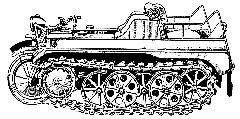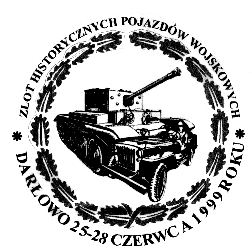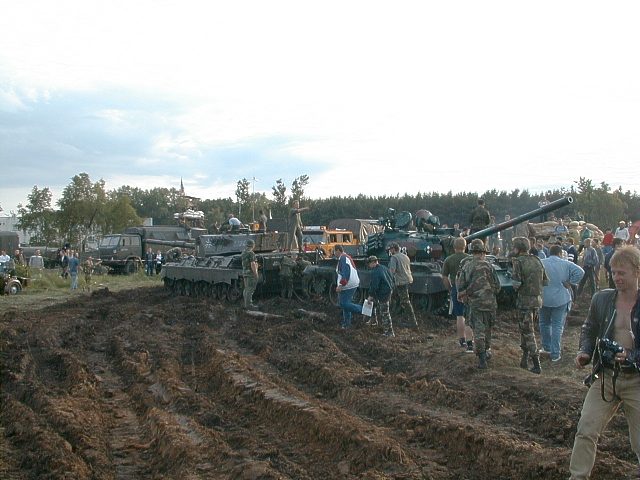

 |
My trip to the MV event at Darlowo, Poland, June 1999 |
Three weeks after the D-DAY-99 event at Normandy another interesting MV event took place. The town mayor of Darlowo (up to 1945: Rügenwalde) at the coast of the Baltic Sea called for a tank and MV event in Poland.
German MVs in Poland, that would be an interesting event. I've never been in Poland before, so it was a real adventure.
We decided to drive to the event with a real MV. Because my Kettenkrad is still not on the road, we took the opportunity to drive in the VOLKSWAGEN ILTIS "Jeep", owned by a friend of ours. The friend was there with more MVs than he could drive, so he needed a driver to drive the TATRA 813 8x8 truck back home. That was my job.
One day before the start there was a shock: A friend told me, that one needs a passport for Poland. My passport has been void for years and in the remaining time it was impossible to get a new one. The ADAC (German automobile club) told me, that it is also possible to go to Poland only with a German identity card, but that in this case you need an extra document, which cost 20 to 100 DM, depending on the customs officer. Oh dear! But the time was to short and so we decided to dare to travel only with the identity card.
We started on Friday with the ILTIS eastbound: My friend Carsten, my wife Regina and I. We drove through the former East Germany (GDR) to Berlin, drove on the Autobahn ring road around Berlin (like the M25 around London, only 50 years earlier) and headed to Stettin to cross the border to Poland.
The closer the border came so more we became alarmed. Would they let us in, only with the identity card? Would we have any trouble at the border with the camo pattern painted ex Bundeswehr ILTIS? How much money would they take for the extra document?
When we came to the border station, we handed our identity cards to the Polish
immigration officer and waited. He looked at them said "Thank you" and let us drive
on! No trouble, no extra money, no waiting!
(When I remember my "French customs experience" last year on the way to Beltring...)
So we went on driving eastbound, much relieved.
The state of the Autobahn was not bad and after some miles the Autobahn ended and went on as a National Road, which was also in a good condition. We had to drive around 130 km (80 miles) from the polish border to our destination Darlowo. We arrived there without any problems. The first surprise was, that Darlowo (former Rügenwalde) is an active seaside resort with lots of "normal" tourists and hotels etc.
First we drove to the event site to have a look. On Friday afternoon there were already a lot of vehicles on the site, including some tanks. There was an off road area and the vehicles were driving frequently in the mud.
We drove to our hotel and were glad to see the sign "Deutsch Sprach Pension" (One speaks German). This made many things easier.
 |
The DKW Munga "Jeep" comes from the right, so it has the right of way... |
On Saturday a lot more vehicles came to the site. Most of them were privately owned but there were also two tanks (including crews) which were in active duty in the Polish army!
Here a small list of the MVs, which were on the event site:
| LEOPARD 1 A4 (German MBT) |
| T55 (Russian MBT in active Duty in the Polish Army) |
| T72 Recovery Tank (Russian recovery tank, ex. NVA) |
| PT 76 amphibious tank (Russian) |
| 2 x T34 Tanks (1 x complete, 1 x without turret) |
|
BMP (Russian APC, tracked, amphibious, in active duty in the Polish Army |
| BTR 60 (Russian APC, wheeled 8x8, amphibious) |
| 2 SIL amphibious trucks (Russian copy of the DUKW) |
| 2 TATRA 813 8x8 trucks (Prime movers) |
| 2 KRAZ 255 6x6 trucks |
| Sd.Kfz. 251 APC (The real thing, not a modified Czech OT!) |
Click on the description of the vehicle to see a picture!
These were only the big vehicles. There were also a lot of smaller MVs: Motorbikes, "Jeeps" and trucks. Many of them of russian origin.
Most of these vehicles were driving on the off-road terrain all the day. Loaded with lots of people. A lot of tourists were comeing with their families to see the MVs. The sound of the big tank engines was in the air all the weekend.
 |
The site with the big vehicles. Behind the trees is the beach and the Baltic Sea. |
The T55 tank from the Polish army stuck in the mud. The tracks were running, but nothing happened, because the belly of the tank lay flat on the ground.

No problem, there was heavy recovery equipment: The LEOPARD tank towed the T55 out of the mud. The picture was taken, when the T55 was back on hard ground and the crew removed the towing cable.
On Saturday we made a parade through the town. I drove the TATRA 813 with around 12 passengers on the cargo bed. The roads in the town were small and some corners were really tricky for the 8x8 truck, but it worked. More problems had the LEOPARD 1 tank. A Polish police car drove in front of it and the town mayor sat in the turret of the tank.
Sorry, no pictures from the parade, because I had to drive the TATRA 813.
At Darlowo (Rügenwalde) there was a test firing position of the 80 cm K(E) railway gun, better known as DORA. This was the biggest gun, which ever saw service. The gun came in pieces, loaded on two complete railway trains. The crew, which was needed to operate this gun, was 2,000 men. Plus around 7,000 men to prepare the firing position and to protect the gun. In total 9.000 men!

Here at Darlowo (Rügenwalde), the gun was tested, firing on the Baltic Sea. These test firings took place in November/December 1941, before the gun was sent to the Crimea for shelling Sevastopol.
See the Dora gun position today in satellite view:
Dora gun position (GOOGLE EARTH. Google Earth software required!)
Dora gun position (MAPS LIVE. No special software required)
It was a big site, where the parts, which came with two freight trains, were assembled with big portal cranes. (The breech block alone was 400 metric tons!) Around the assembly site there was a big fence, which made it impossible to view at the site. You can see the fence on the historic picture above, just left from the gun.
The fence is more than 10 meters high and the fenced area is around 150 x 400 metres. There was no roof on the top. Protection against aerial view was not a matter, because the site was out of the range of Allied aircraft in 1941.
Next picture shows the site during our visit in 1999. You can see the concrete remains of this fence. The spaces between the piles were closed with timber, which is gone today.

In the foreground the foundations for the rails of the portal cranes are visible.
This place is (nearly) the only thing which is left of the biggest gun ever made. It is today part of a camp of the Polish Army and closed to the public. We had the permission to enter the site with our historic MVs and a polish officer guided us to the site. This was really an experience in 1999!
On Sunday morning we started on our way back to Germany. Over 600 km (375 miles) in the TATRA were before us. The first few kilometres on small country roads were a little bit tricky, because the roads in the villages were not made for big trucks. The sound of the roaring air cooled V12 Diesel engine came back from the walls of the houses.
 |
On the way back home. My wife Regina in the top hatch of the TATRA 813. Behind the TATRA the ILTIS "Jeep", which we used on the journey over. |
On the way back to the border we filled up the fuel tanks of the TATRA to 200 litres, because you may not take Polish money abroad and you also may not have more than 200 litres fuel in your tanks.
On our return tour we had again no trouble at the border control, in five minutes everything was done. The TATRA was doing well, going westbound at 50 mph. The sound of the air cooled V12 Diesel engine with 18 litres capacity is incredible. So my wife and I drove all the day with ear muffs...
Without any problems we arrived back at Braunschweig at Sunday evening. It was a big trip and a real adventure.
©Andreas Mehlhorn 1999-2025